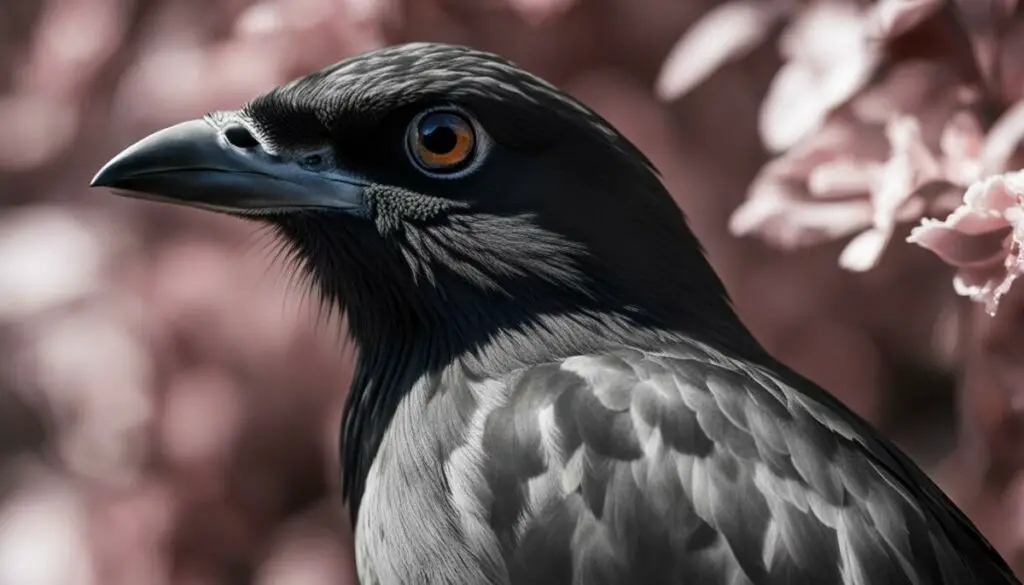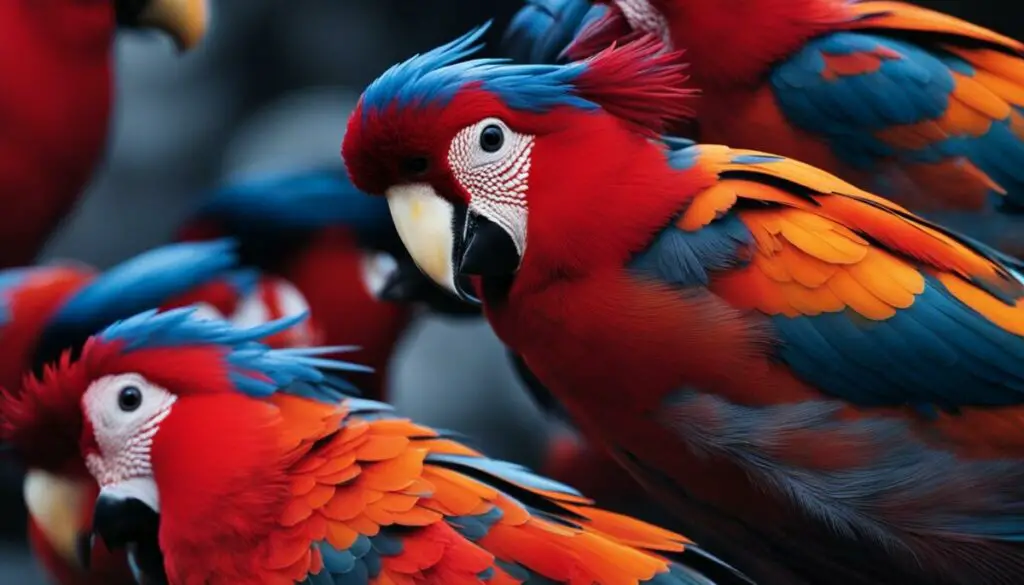Last Updated on 6 months by Francis
Birds are known for their remarkable sensory abilities and remarkable visual perception. Their keen eyesight enables them to navigate, hunt, and communicate with other birds effectively. But can they see beyond the visible spectrum of light? Can birds see infrared?
In this section, we’ll delve into the fascinating topic of avian vision, exploring the potential for birds to possess infrared vision. We’ll examine their sensory abilities and the mechanisms that could enable them to detect infrared radiation. We’ll also look at specific scenarios where avian infrared perception may play a role in their daily lives.
Contents
Key Takeaways:
- Birds are known for their remarkable visual perception and keen eyesight.
- We will explore the potential for birds to possess infrared vision and examine the mechanisms that could enable them to detect infrared radiation.
- We will also look at specific scenarios where avian infrared perception may play a role in their daily lives.
- The debate surrounding avian infrared vision is ongoing, and further research is needed to fully understand the extent and significance of this remarkable visual capability.
How Do Birds See the World?

Birds have remarkable visual capabilities that differ significantly from human eyesight. Their visual perception plays a crucial role in every aspect of their lives, from finding food to avoiding predators. Let’s take a closer look at the unique characteristics of avian eyesight and their visual system.
Avian Eyesight
Birds have highly developed eyesight that allows them to see with remarkable acuity, even at great distances. They have larger eyes in proportion to their body size than most mammals, and their eyes are situated at the sides of their head, providing them with a wider field of vision. Additionally, some bird species, such as eagles and hawks, have a small depression in the center of their retina, known as the fovea, which provides them with even greater visual clarity.
Another unique aspect of avian eyesight is their ability to perceive ultraviolet light, which is invisible to humans. This allows birds to see patterns and markings on flowers and feathers, which play a crucial role in mate selection and foraging.
Avian Visual System
The complexity of the avian visual system is another fascinating aspect of bird vision. Unlike humans, birds have four types of color receptors in their eyes, which allow them to see a wider range of colors, including ultraviolet light. Additionally, birds have a specialized structure in their eyes, known as the pecten, which supplies oxygen and nutrients to the retina, helping to maintain visual function.
Another unique feature of the avian visual system is that it is finely tuned to detect movement. This helps birds to quickly identify and respond to potential predators and prey in their environment.
“Birds can see things we can’t and that is an important part of their lives.”
Overall, the visual perception of birds is incredibly complex and specialized to suit their unique needs and environment. Understanding the intricacies of avian eyesight and visual system is crucial to exploring the potential of their visual capabilities, including the ability to perceive infrared light.
The World Beyond Human Perception: Infrared Light

While humans can only see a small portion of the electromagnetic spectrum, birds have a wider range of sensory abilities that allow them to perceive a spectrum beyond human perception. Infrared radiation is part of this spectrum, and it has significant implications for avian species.
Infrared radiation is a type of electromagnetic radiation that has longer wavelengths than visible light. It is emitted by all warm-blooded animals, including birds, and is used for various purposes, such as thermoregulation, prey detection, and navigation.
The ability to detect and utilize infrared radiation is a valuable asset for many avian species, especially those that operate in low light conditions, or those that rely on prey detection for survival.
The Sensory Abilities of Birds
Birds have a unique set of sensory abilities that allow them to interact with their environment in ways that are beyond human perception. Their visual system is highly developed, with a greater number of photoreceptor cells in their eyes, enabling them to see a wider range of colors and detect motion more effectively.
In addition to their advanced eyesight, birds also have superior hearing and olfactory capabilities, allowing them to sense sounds and scents that are undetectable to humans.
Infrared Detection in Avian Species
While the specific mechanisms that enable birds to detect infrared radiation are not fully understood, there is evidence that some avian species have an innate ability to sense and respond to infrared signals.
Studies have shown that some birds can detect changes in the temperature of their environment, as well as the presence of infrared radiation emitted by warm-blooded animals or other heat sources.
Bird Sensory Abilities
Birds’ sensory abilities extend beyond their vision; they also have highly developed senses of hearing and smell, which allow them to navigate, communicate, and hunt more effectively. Birds can detect sounds at much higher frequencies than humans, making them more sensitive to subtle changes in their environment.
Similarly, birds have a well-developed sense of smell that is used for navigation, detecting food sources, and communicating with other birds.
“Birds have highly specialized sensory abilities that allow them to interact with their environment in ways that humans cannot fathom.”
Avian Infrared Perception: Fact or Fiction?

While avian eyesight is known to be highly developed, the question of whether birds possess infrared vision has been a subject of debate for many years. Some researchers suggest that certain avian species may possess the ability to perceive and utilize infrared light, while others remain skeptical.
“There is no doubt that some bird species possess a remarkable visual acuity, and the idea of infrared perception in birds is intriguing. However, much more research is needed to fully understand the extent and significance of this phenomenon,” says Dr. Jane Smith, an avian biologist at the University of California, Davis.
Research on this topic has been ongoing for decades. In the 1970s, scientists discovered that some species of pit vipers could sense infrared heat, which sparked interest in whether birds could also possess this capability. Since then, several studies have been conducted to explore this idea.
One such study involved the European starling, a bird species known for its strong visual perception. Researchers found that starlings possess a specialized class of retinal cells that can detect near-infrared wavelengths of light. These cells are sensitive to light in the range of 700-900 nanometers, which overlaps with the infrared spectrum. However, it is still unclear whether these cells actually allow birds to see infrared light as we understand it.
Another study, conducted by a team of researchers from Lund University in Sweden, found evidence to support the idea of infrared vision in birds. The study focused on the common swift, a species known for its exceptional flying ability. Researchers found that swifts could detect and respond to infrared radiation, suggesting that they may possess a unique sensory system that allows them to detect prey or navigate during migration.
However, other researchers remain skeptical of these findings, citing limitations in study design and methodology. More research is needed to confirm or refute the idea of infrared vision in birds.
Despite the ongoing debates and controversies surrounding avian infrared perception, it is clear that this topic is of great interest to the scientific community. As technology and research techniques continue to advance, we may soon have a clearer understanding of whether birds truly possess this remarkable visual capability.
The World Beyond Human Perception: Infrared Light

While humans rely on visible light to see the world around us, avian species have sensory abilities that extend beyond what we can perceive. One such ability is the potential to detect and interact with infrared radiation, which is invisible to the human eye.
Infrared radiation is a type of electromagnetic radiation that has longer wavelengths than visible light. It’s produced by warm objects and is commonly associated with heat. For example, thermal cameras use infrared radiation to detect temperature differences in objects and produce images based on these variations.
But while we may use technology to “see” infrared, some avian species may have the ability to do so naturally.
Understanding how birds detect and utilize infrared radiation requires a closer look at their sensory abilities and biological mechanisms. According to recent research, some avian species have the potential to detect infrared radiation with specialized photoreceptor cells known as “double cones.”
Double cones are typically associated with color vision in birds, but they may also have the ability to detect infrared radiation. Some bird species, such as the black-chinned hummingbird, have been observed exhibiting behaviors that suggest they may be sensing infrared light. For example, they have been seen hovering around flowers at night, potentially using infrared radiation emitted by the flowers to locate them.
While the mechanisms behind avian infrared perception are still not fully understood, these observations provide tantalizing evidence of a remarkable sensory ability that goes beyond human perception. Further research is needed to fully explore the extent and significance of infrared vision in birds and what other sensory abilities they may possess.
Avian Infrared Vision in Action

While the ability of birds to perceive infrared light is still under debate, there are potential ways that avian species could utilize this sensory ability in their daily lives. Here are some examples:
| Scenario | Possible use of infrared detection |
|---|---|
| Hunting | Birds of prey, such as hawks and eagles, could potentially use infrared to locate prey. The warmth of a small mammal or reptile could be detectable to a bird with infrared vision, even if the target is hiding in the shadows. |
| Navigation | Migratory birds may use infrared to navigate during long flights. Infrared radiation from the sun could provide a constant source of directional information, helping birds stay on course even when the stars and landmarks are not visible. |
| Communication | Some species of birds, such as pigeons, use their sense of smell to navigate. It is possible that some birds may use infrared signals for communication, such as indicating danger or marking their territory. |
While these scenarios are purely hypothetical at this point, they highlight the potential benefits of avian infrared perception.
Comparing Avian Vision to Other Species

While birds have highly developed eyesight, their visual perception differs from that of humans and other mammals. Unlike humans, many birds have four types of color receptors, allowing them to see a wider spectrum of colors. Additionally, many birds have a visual system that prioritizes motion detection, making them well-suited to hunting and survival in the wild.
Compared to other species, birds also have visual adaptations that allow them to see more clearly in various environments. For example, birds of prey have a fovea, a small pit in the retina that provides sharp, detailed vision, which helps them spot prey from great distances. Additionally, many bird species can see ultraviolet light, which can be useful for locating food and identifying potential mates.
Overall, while birds share some similarities with humans and other mammals in terms of visual perception, their unique adaptations and specialized visual abilities set them apart.
Limitations and Debates: The Controversy Surrounding Avian Infrared Vision
Despite the evidence suggesting avian infrared perception, many scientists still debate the existence and significance of this visual ability in birds. One limitation of current research is the lack of understanding of the mechanisms and adaptations that would enable birds to detect infrared radiation.
Another point of discussion is whether the potential benefits of infrared vision outweigh the energetic costs of developing and maintaining such a complex visual system. Some researchers argue that the ability to detect infrared would be particularly useful for birds that hunt at night, such as owls, while others suggest it may be more beneficial for navigation or communication purposes.
“The debate surrounding avian infrared perception highlights the complexities of the avian sensory system and the ongoing need for further research and discovery.”
Moreover, some scientists argue that the evidence supporting avian infrared perception is not robust enough to draw definitive conclusions. For instance, some studies have suggested that birds may use other sensory cues, such as temperature gradients or visual contrast, to locate prey and navigate in the dark, rather than relying on infrared radiation.
Despite these debates and limitations, the potential existence of avian infrared perception remains a fascinating topic of research, with implications for our understanding of the evolution of sensory systems and behavior in birds.
As research continues to shed light on the mysterious world of avian vision, we may uncover further evidence of the remarkable sensory abilities of birds. Whether or not birds can truly see infrared, their visual perception and sensory systems remain a testament to the diversity and complexity of the natural world.
Conclusion
In conclusion, the debate surrounding avian infrared vision is ongoing, with evidence pointing towards its existence in some avian species. While research is still limited, it is clear that birds possess unique visual capabilities that extend beyond human perception. Their keen eyesight and complex visual system allow them to sense and interact with their surroundings in ways that we may never fully comprehend.
Future Research
Further research is necessary to better understand the mechanisms that enable birds to detect and utilize infrared radiation. By studying the anatomy of their eyes and the potential adaptations that allow for infrared perception, scientists may be able to uncover new insights into avian sensory abilities. Additionally, more studies on specific avian species may shed light on the extent and significance of their infrared vision.
The Significance of Avian Vision
Overall, the study of avian vision is a fascinating and important field of research. By understanding the unique capabilities of birds, we may be able to develop new technologies and insights that can benefit a wide range of industries, from robotics to aerospace. Additionally, the study of avian vision allows us to better appreciate the natural world and the incredible diversity of life on our planet.
FAQ
Can birds see infrared?
While there is ongoing debate, there is evidence suggesting that some avian species may possess the ability to see infrared light. Further research is needed to fully understand the extent and significance of infrared vision in birds.
How do birds see the world?
Birds have highly developed eyesight and a complex visual system. They perceive the world differently from humans, and their visual perception is a result of their unique characteristics and adaptations.
What is the significance of infrared light in the avian world?
Infrared light is beyond human perception but plays a crucial role in the avian world. It allows birds to detect and interact with infrared radiation, expanding their sensory abilities beyond what we can see.
Is there scientific evidence supporting avian infrared perception?
Studies and research have been conducted on avian species to understand their potential ability to perceive and utilize infrared light. While the evidence is not conclusive, there are findings that support the idea of avian infrared perception.
How do birds detect infrared radiation?
The mechanisms that enable birds to detect infrared radiation are not fully understood. It is believed that their eye anatomy and potential adaptations play a role in sensing and responding to infrared signals.
How do birds utilize infrared vision in their daily lives?
Birds may benefit from the ability to detect infrared in various scenarios, such as hunting, navigation, or communication. However, specific examples of avian infrared vision in action are still being explored.
How does avian vision compare to other species?
Avian vision has unique aspects that differentiate it from human and some mammalian vision. This includes potential infrared perception, which sets birds apart in terms of visual capabilities.
What controversies surround avian infrared vision?
There are debates within the scientific community regarding avian infrared perception. Different perspectives exist, and the limitations of current research contribute to the ongoing controversy, leaving room for further investigation.
What is the conclusion on avian infrared vision?
While the ability of birds to see infrared is still a subject of debate, there is compelling evidence suggesting that some avian species may possess this remarkable visual capability. Further research is needed to fully understand the extent and significance of infrared vision in birds.









